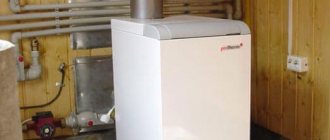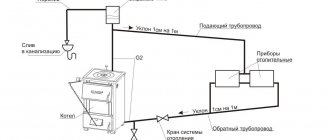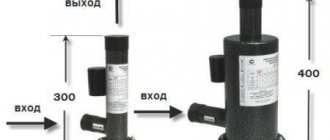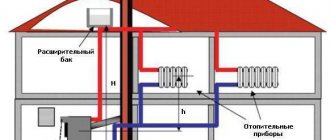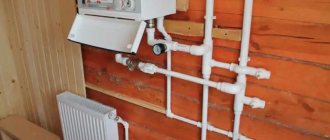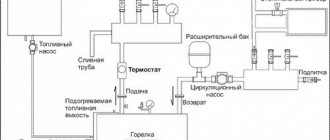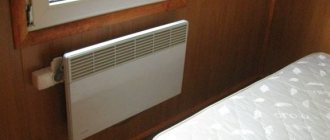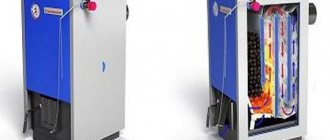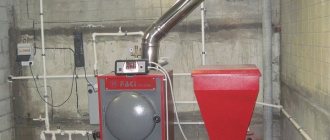It often happens that in a private house there is no possibility of connecting to central communications due to the great distance from them. This problem is especially relevant for new cottage villages that are actively populated, but communications are planned to be completed in the next couple of years. If you find yourself in such a situation and want to live in your own home this coming winter, the best solution for you is to install an autonomous heating system with your own boiler room.
In most cases, cottage owners prefer solid fuel boiler models that burn wood, coal, and pellets. Solid fuel is familiar, effectively copes with its task and is inexpensive.
In this article, we will analyze the advantages and disadvantages of different connection schemes for boiler equipment operating on solid fuels, and tell you how to properly install a boiler so that the building’s heating system functions smoothly, efficiently and safely.
The procedure for installing a solid fuel boiler in a private house
The installation procedure traditionally includes 3 stages, including:
- Preparation of premises for a boiler room or construction of a separate building.
This stage involves finishing surfaces with non-flammable material, providing ventilation, and installing windows. It is also necessary to provide electricity to organize lighting and connect to the power supply of the heating boiler. It is advisable to entrust the last task to specialists with appropriate qualifications and experience in electrical installation work. - Installation of the boiler on a pre-prepared foundation.
The equipment must be located strictly vertically, stable, on a rigid foundation. A smooth cement screed should be made on the floor, the thickness of which should not be less than five centimeters. In this case, a bedding of the same thickness is first created. It is recommended to install the expansion tank not in the boiler room, but at the highest point of the house. The optimal place is an unheated attic. In this case, it is recommended to additionally carefully insulate the tank to avoid freezing of the coolant during the winter months. - Piping
- connecting a solid fuel boiler directly to the heating system itself.
There are several strapping options, below we will talk about them in detail.
Boiler room arrangement
One of the most important stages that should be taken as seriously as possible is the arrangement of the boiler room (furnace room) - the room in which the boiler is supposed to be installed. The boiler room must be equipped in accordance with all fire safety requirements, including:
- The solid fuel boiler must be installed in a separate non-residential premises, the area of which must be at least 7 m2. Please be aware that when using solid fuels, some dust and smoke will be generated. The optimal places to place a solid fuel boiler if you do not want or do not have the opportunity to equip a separate boiler room are a garage or basement. A window is required.
- For the smooth and efficient operation of heating equipment, it is necessary to have high-quality supply and exhaust ventilation. This is primarily due to the fact that normal combustion of fuel requires a large amount of oxygen. Experts recommend choosing a combined type of ventilation system, which involves organizing a natural flow of outside air through a ventilation hole and forcing it out into the street through a special outlet equipped with an electric fan.
- The floor, ceiling and walls of the boiler room must be finished with fire-resistant materials. The best option is ceramic tiles. A concrete screed with a thickness of at least 5 cm should be made on the floor. In an emergency, these measures will prevent the spread of flame to other rooms of the house and generally increase the safety of using a solid fuel boiler.
Also, in order to ensure fire safety, it is necessary to leave as much free space around the boiler as possible and not install it close to the wall.
Read more about the boiler room in a private house on our Zen channel.
Selecting a room to place the unit
Let's look at it in as much detail as possible, what is a boiler that runs on solid fuels? This is a thermal device equipped with an open combustion chamber.
The scheme for connecting it to the heating system of a private house can be based on the technical requirements for open or closed heating systems. Everything will depend on the operating conditions.
The requirements for open systems are:
- connecting the system for removing solid fuel combustion products to a chimney in which draft will be carried out naturally;
- installing an expansion tank at the highest point of the heating circuit, through which a connection between the coolant and the atmosphere will be established;
- constant provision of the heating system with the water necessary to maintain it in working order.
Although owners of private houses more often install closed heating systems rather than open ones.
All solid fuel boilers have quite impressive dimensions. Therefore, they are manufactured exclusively in a design that provides for floor placement.
Before you begin installing a solid fuel boiler, you should clearly determine the location, layout and method of its installation.
Installing a solid fuel boiler involves a considerable amount of work:
- determination of premises for placement of a solid fuel thermal generator;
- preparatory work in the boiler room;
- installation of a supply and exhaust ventilation system;
- installation of a boiler and chimney system;
- boiler piping;
- test run of the heating system.
Only by following this algorithm of actions can problems be avoided during the installation of a solid fuel unit, as well as during its further operation.
An ideal option for arranging a boiler room when all heavy equipment is installed on the floor
Points 1-3 of the above work order represent preparatory work. But this does not mean that their implementation should be approached less scrupulously than the installation work itself.
If you choose the wrong room for installing a heating unit and make mistakes when installing the ventilation system, problems with the operation of the heating system of a private home will not take long to occur. And a solution will have to be sought at the height of the heating season, during the cold season.
Therefore, it is better to immediately correctly install both the heating equipment in a private house and the solid fuel boiler itself. To do this, it is necessary to develop in advance a detailed installation diagram, taking into account that the installation of some types of solid fuel boilers may involve power supply from the electrical network.
One of the correct options for installing a solid fuel thermal unit involves placing it in the basement, first or basement floor
When it comes to installation, you have to rely on the basic standards of SNiP “Heating and Ventilation” and some provisions of SNiP 31-02-2001 “Single-apartment buildings” (for the Russian Federation).
Burning solid fuels increases the level of dust in the room, and when burning wood or coal, varying amounts of smoke can leak into the room.
Therefore, installing the boiler in close proximity to residential premises is undesirable. Although, according to regulatory documents, the installation of a solid fuel boiler is permitted in the kitchen, hallway and other non-residential rooms.
A boiler room in the form of an extension can be built near the house. This design solution will be quite convenient
The optimal place to install the boiler is in a separate specialized room, preferably separated from the house. As an option, a properly equipped technical room attached to the house is suitable.
It is also a good option to place the heating unit in the basement or garage. You can install it in the corridor, but provided there is sufficient space and good ventilation of the room.
Boiler piping diagrams
Owners of private houses who install their own heating system, as a rule, choose the simplest piping scheme. This option involves connecting boiler equipment to the heating system on both sides - to the supply pipeline and to the return pipeline - through a pair of pipes.
This wiring scheme is good because it is completely autonomous in relation to the power grid. Even in the event of power outages, the system will function properly.
The main and very significant drawback is that it is not possible to regulate the temperature of the coolant at the outlet of the heating equipment, which can ultimately lead to such adverse consequences as the appearance of rust on the surface of the pipes and boiler.
This connection option is quite popular due to the fact that even a non-specialist can do it. At the same time, there are more complex piping schemes that require the possibility of adjusting the temperature of the coolant, which should not fall below 60 °C, and, at the same time, boiling is also extremely undesirable. Compliance with this condition allows us to eliminate the following adverse events:
- a regularly occurring large temperature difference in the heat exchanger, which contributes to a reduction in the service life of the equipment and its maintenance-free operation;
- condensate formed on the inner surface of the combustion chamber.
The latter is especially important, since condensate is nothing more than weak solutions of low concentration acids that can corrode the walls of the boiler.
Installation of a wall-mounted boiler
If you want to install a gas boiler for a private home with your own hands, then the first thing you need to do is choose the type of equipment: floor-standing or wall-mounted boiler. Each of them has its own advantages and disadvantages.
Mounting the boiler to the wall should be as reliable as possible.
Next we will talk about installing a wall-mounted boiler:
- Selecting a location for installation. It is necessary to take into account the fact that for other equipment the distance from the boiler wall should exceed 20 cm. In addition, you will have to make a small indentation of 30–50 mm from the wall (depending on the power of the boiler). It is allowed to mount the boiler on the wall above other equipment located on the ground floor of the house if there are several units in the boiler room.
- Before installation, be sure to check whether all the necessary elements for work are in place: installation design, instructions, mounting brackets, screws, etc.
- A plate with all the technical characteristics of the unit must be placed on the boiler lid. Before installation, it is necessary to check the indicated indicators with those shown in the instructions and on the packaging. If everything matches, then installation can begin.
- If the walls on the ground floor of the house are made of wood or any other material exposed to fire, then a shield made of heat-insulating material with a thickness of 3 mm or more must be installed between the wall and the unit. In addition, it is necessary to provide a distance of 50 mm from the boiler to the wall.
- Next, the brackets are attached. It is best to fix the brackets with dowels. The instructions always indicate the scheme in accordance with which this is best done. It should be noted that according to the rules, it is recommended to install a wall-mounted boiler at a height of 80–150 cm above the floor.
- Then the mounting strips are attached to the boiler. Fastening can be done in different ways (everything will depend on the specifics of the unit and the manufacturer). As a rule, ordinary bolts or self-tapping screws are used. In this case there will be no unclear details.
- Before hanging the boiler on the brackets, it is necessary to rinse all the pipes of the unit with cold water in order to remove particles from them that entered the system during the production and transportation of the equipment.
- The boiler must be hung on pre-installed brackets using a mounting strip. This is done as specified in the instructions provided by the manufacturer. The boiler must be positioned horizontally, otherwise problems may occur during operation.
- We find a pipe that supplies water to the heat exchanger, after which we install a special filter on it, designed to prevent clogging of the boiler during operation. The filter on both sides must be equipped with ball valves, with the help of which, if necessary, you can quickly repair and service the equipment.
- Gas-type boilers are connected and put into operation only by licensed employees of the relevant companies, so you cannot do this yourself.
The boiler room of a country house can have several boilers at once, if, for example, the house is multi-story or large, or heating of neighboring outbuildings (garage, barn, etc.) is required. The requirements in this case change slightly.
Basic strapping scheme
When choosing a method for connecting a solid fuel boiler to the heating system, special attention should be paid to the installation of the mixing unit, as well as the safety group. The latter is the first element of the system encountered on the path of the heated coolant. The security group includes:
- a pressure gauge that monitors the pressure in the system;
- safety valve - discharge of excess coolant and steam;
- an air vent that eliminates the occurrence of air jams;
Such equipment is presented in the “Related Products” section of our online store under the name “Security Group”. Its main purpose is to ensure trouble-free operation of the heating system. The pressure gauge, air vent and valve are mounted on a single manifold made of stainless steel. It allows you to reduce the pressure in the system automatically.
We recommend reading our article Types of safety automation for gas boilers on our Zen channel.
Installation of the mixing unit
After completing the installation of the safety group, you can begin installing the mixing unit - a return jumper that connects the supply circuit of the heating system with the return circuit. During operation of the system, the liquid, bypassing the heating devices, gives off heat and returns to the boiler for heating.
If this circuit operates correctly, when the coolant temperature drops below 60 °C, the jumper will open automatically, a small volume of hot water will enter the return circuit and the temperature will return to the desired value.
Solid fuel boilers "Kupper" are universal heating equipment capable of operating in open and closed systems, where forced or natural coolant circulation is provided. Such a boiler can act either as an independent source of heat energy, or as an additional one - as part of an existing heating circuit, in tandem with another boiler running on gas, electricity or liquid fuel.
An additional advantage of purchasing a Kupper boiler is that a thermometer for temperature control is included with the heating equipment.
Connecting a solid fuel boiler with a heat accumulator
If the boiler does not have the option of automatic fuel supply, you will have to monitor the amount of fuel in the firebox yourself and periodically load a new portion into the flame. The more actively the boiler is heated, the more intensively the heating system works. This is not very convenient, because a lot of time is spent on the above manipulations to maintain the desired temperature in the room.
This inconvenience can be partially overcome by a buffer tank - a kind of heat accumulator, which is a tank of water, the heating of which occurs from the supply circuit of the heating system. The list of advantages of installing it is:
- the ability to reduce the elevated coolant temperature at the peak of boiler operation;
- heat transfer to the cooled coolant when the temperature of the liquid in the system decreases.
It takes quite a long time for such a heat accumulator to cool down. When choosing a buffer tank, assume that for a house with an area of 150 m2 or more you will need a tank with a volume of at least 1 m3.
Additional mixing unit
An additional mixing unit is mounted in the area between the buffer tank and the heating radiators. This element of the system connects the return and supply circuits and allows you to avoid strong temperature differences when the coolant almost begins to boil at the peak of the boiler operation.
By the way, for solid fuel boilers “Kupper” with an automatic pellet burner, an additional mixing unit is not needed and when installing them, you can safely limit yourself to the most primitive piping scheme.
In the Kupper OVK 10 model, an automatic pellet burner (APG) is installed in place of the ash door of the boiler, and the container into which pellets are loaded and the built-in control panel are installed on the boiler itself, which saves space in the room. Before starting the work process, the operating parameters of the heating system are set on the remote control. Using an automatic remote control, you can control the ignition, combustion process and maintain a balanced temperature of the coolant without the participation of additional mixing units that complicate installation. Another advantage of this model is that the ash is partially removed under the influence of a built-in high-power fan.
This boiler is suitable for installation in rooms up to 100 m² and can be used in a residential building, country house, garage, and other places. The equipment can be easily integrated into different types of heating systems. A nice bonus is the presence of a stove with a hob.
Boiler room requirements
- What are the requirements for the boiler room if you plan to place a solid fuel boiler or a stove equipped with a heat exchanger on the ground floor?
The photo shows a stove equipped with a heat exchanger in the basement of a cottage.
Introduced in 1996, the instructions for installing heating equipment in paragraph 4.2 indicate that the power of the boiler or any other heat source when installed in the basement should not exceed 350 kW.
Besides:
- Ceiling height - 2.5 meters or higher;
- The fire resistance limit of the walls is at least 0.75 hours;
- The boiler room must have natural light. The window area (see Windows in the basement: dimensions, configuration and installation) must be at least 0.03 square meters per cubic meter of room;
- The ventilation system must provide exhaust in a volume that ensures complete air renewal 3 times per hour, and inflow in the same volume, adjusted for air flow during fuel combustion.
Please note: there are no restrictions on the area and volume of the boiler room when placing them in the basement. The document only indicates that the premises must provide convenient access to the equipment located in it.
The dimensions of the boiler room in the basement are not regulated
- Are the requirements for the boiler room more stringent if you plan to install a gas boiler on the ground floor?
The answer can be found in paragraph 6.18 of SP 42-101-2003:
- The ceiling height with a power of gas equipment less than 60 kilowatts can be reduced to 2 meters, with a higher power its minimum value is 2.5 meters;
- The requirements for ventilation and window area completely coincide with those described above;
Skylight in the basement gas boiler room
- The fire resistance limit of enclosing walls should not be less than 45 minutes;
Reference: such fire resistance is provided, for example, by brickwork 25 centimeters thick (in brick).
- When the power of gas equipment is 150 kilowatts or more, the boiler room in the basement must have a separate outlet.
If you plan to install a gas boiler in the basement, the requirements of SNiP 42-01-2002 will also have to be taken into account: regardless of the power of the equipment, the boiler room must have a gas control system that can automatically shut off the gas supply.
Gas control system design
Emergency circuit connection diagram
One of the obvious and most common problems that occur in heating systems with solid fuel boilers is overheating of the coolant. It is extremely undesirable to allow hot water to be converted into steam and to cool it down to the required levels in a timely manner.
What to do if the boiler gets very hot - read on our Zen channel.
There are three simple and effective methods of cooling the coolant:
- In addition to the main one, an additional heat exchanger is installed in the firebox. The first will work to heat the coolant, the second will provide cooling of the liquid. The inlet pipe connects to the water supply, and the opposite pipe connects to the sewer. If you urgently need to cool the coolant, simply unscrew the valve on the pipe and cold water will flow into the second heat exchanger.
- During the process of arranging the system, one heat exchanger is mounted inside another, which ensures a rapid decrease in the temperature of the working fluid if necessary.
- Two pipes are connected to the heat exchanger pipes, the first is connected to the water supply system, and the second to the sewerage system. Next, a valve is installed to supply cold water to the system. Excess coolant is discharged into the sewer.
All three methods are equally effective and achieve the same results.
Search for information
To know how to properly connect a solid fuel boiler, you do not need to have a higher engineering education or work in a service company.
Any normal manufacturer of boiler equipment supplies its products with detailed installation instructions. The same manual specifies all the requirements that apply to the installation of a solid fuel heating boiler in residential buildings and industrial buildings.
Of course, installing a solid fuel heating boiler in an industrial building is an activity only for professionals, I won’t argue here.
But when it comes to a small residential building where a low-power heat generator is installed, you can do everything yourself, be it preparing the site or piping a solid fuel boiler, without involving specialists.
The installation of solid fuel boilers is regulated by Construction Norms and Rules (SNiP) and Fire Safety Standards (FSN). It is allowed to install a solid fuel boiler with your own hands, subject to the regulations of these two documents.
Where can I get information on all the work performed and the requirements? Just not on information sites or forums!
Why? Because it concerns your personal safety and the safety of your family members. Therefore, information can only be taken from the texts, I repeat, the texts of the regulatory documents indicated above.
No amount of rumors and speculation from comrades on the Internet can replace the text of an official document. Only an official document, SNiP or NPB, can provide you with 100% reliable information.
Where to look? On any site that publishes the unmodified text of the above documents. It’s even better to search on the official websites of the representative offices of the largest manufacturers of boiler equipment. They are ready to be responsible for the information that they post on their website.
And then, when you have studied the texts of the NPB and SNiP, when you know all the requirements and rules, you can install the solid fuel boiler yourself.
Additional connection diagrams for a solid fuel heating boiler
We recommend that you pay attention to such an important circumstance that directly affects the choice of piping scheme for solid fuel boilers, such as interruptions in the electrical network that occur from time to time. This is fraught with a sudden boiling of the coolant with all the ensuing consequences. This problem can be solved by installing a bypass, which will isolate the circulation pump from the heating circuit.
Bypass (emergency path) is a backup pipeline through which coolant can be supplied bypassing some section of the main pipe or in parallel. One end of it is connected to the inlet pipe, the other to the outlet pipe. A bypass is often used to install additional devices on it, for example, shut-off valves, with the help of which, if necessary, they block the water flow in the main line, redirecting it to the spare one. To completely shut off the system, the outlet pipe is equipped with a tap. Shut-off valves can also be mounted on the bypass, on the inlet pipe.
Read more about bypasses on our Zen channel.
Choosing a heating scheme for a heating boiler in a private house
The boiler itself is only an element of the heating system. Without pipes and radiators through which the coolant circulates, its work is useless. Therefore, heating wiring must be provided in advance, before purchasing a unit that produces heat. The task is made easier by the fact that the heating circuit for all types of boilers has more similarities than differences.
Gravity diagram
Most often, this scheme is used for connection with a solid fuel or liquid boiler. If we approach the issue strictly, taking into account the preservation of efficiency, then modern gas boilers do not require gravity circulation of the coolant. Many wall-mounted and floor-mounted models with electronic control already have a built-in circulation pump, which forcibly drives water or antifreeze through pipes and radiators. In conditions of frequent power outages, such a boiler will be inactive.
General view of the gravitational scheme
However, in many houses, gravity circuits continue to operate in conjunction with a simple gas non-volatile boiler with mechanical control. By using large diameter heating pipes, the system creates sufficient water pressure to start the gas burner. In old systems, pipes with a cross-section of 100 - 150 mm were used, which encircled the rooms around the perimeter. The heat transfer of such a design is low, but it itself is reliable and durable. When installing radiators, the diameter of the supply pipes must be at least 40 mm to reduce hydrodynamic resistance.
In gravity systems, an expansion tank is a mandatory element. If the water in the system reaches high temperatures, excess water enters the tank due to the increased volume. The tank insures the system against leaks and depressurization in the event of an abrupt increase in pressure. In open-type systems, the tank is always located at the top point.
The gravity circuit is single-pipe. This means that the coolant sequentially passes through all the radiators, and then returns through the “return”. To install batteries in such a system, bypasses are used - bypass pipes with shut-off valves, thanks to which it is possible to dismantle and replace batteries without stopping the boiler and draining the coolant. Also, a Mayevsky valve is installed on each radiator to bleed the air that accumulates inside the wiring.
Mayevsky crane
Forced circulation circuit
The only disadvantage of this type of heating wiring is the dependence on the presence of voltage in the household electrical network. In addition to the boiler, the second important component of such a scheme is the circulation pump, which cuts into the “return” before returning it to the boiler. Modern pumps are silent, efficient and consume electricity like an incandescent light bulb. But thanks to this device, it becomes possible to make a choice in favor of a two-pipe system. In this case, the piping pipe passes through all heated rooms of the house. From it, a separate stream of hot water is supplied to each battery, and from it the cooled coolant is drained into the “return”, which is the very second pipe in the circuit. This allows you to distribute heat evenly across all radiators and maintain the same temperature even in the rooms furthest from the boiler.
If there is a circulation pump, the expansion tank must be closed so that a certain pressure can be created in the system. In case of exceeding normal values, an emergency pressure relief valve is provided.
Visual representation of a two-pipe circuit
In both schemes, a make-up unit must be provided through which coolant is poured into the system. If water is used, then a pipe from the water supply network is cut in to fill the pipelines, installing a filtration system at the inlet. When using antifreeze, an inlet valve with shut-off valves is installed, and injection is carried out using a “baby” submersible pump or other pumping equipment.
Combination boilers
Recently, combination boilers, which provide continuous heating of the coolant regardless of external circumstances, are gaining increasing popularity. The system can be supplemented with another boiler, gas or electric. The connection diagram for an electric boiler to a solid fuel boiler is carried out in a parallel way. Equipment with insertion into the supply and return circuits is added to the piping. Shut-off valves must be installed at the junction of two connections. In the case of an automated system, a 3-way valve with a thermal head is used.
The assortment of our online store includes boiler models that can be used in similar schemes, for example, “Kupper Praktik 20”. This equipment is designed to heat rooms with an area of 130-200 m2 and can operate on both coal and wood. Thanks to its compact size, it takes up little space. Another option, “Kupper Praktik 8”, is intended for small rooms from 40 to 80 m2. Thanks to the presence of a heating element block, the coolant temperature is maintained for some time after the fuel has burned out.
